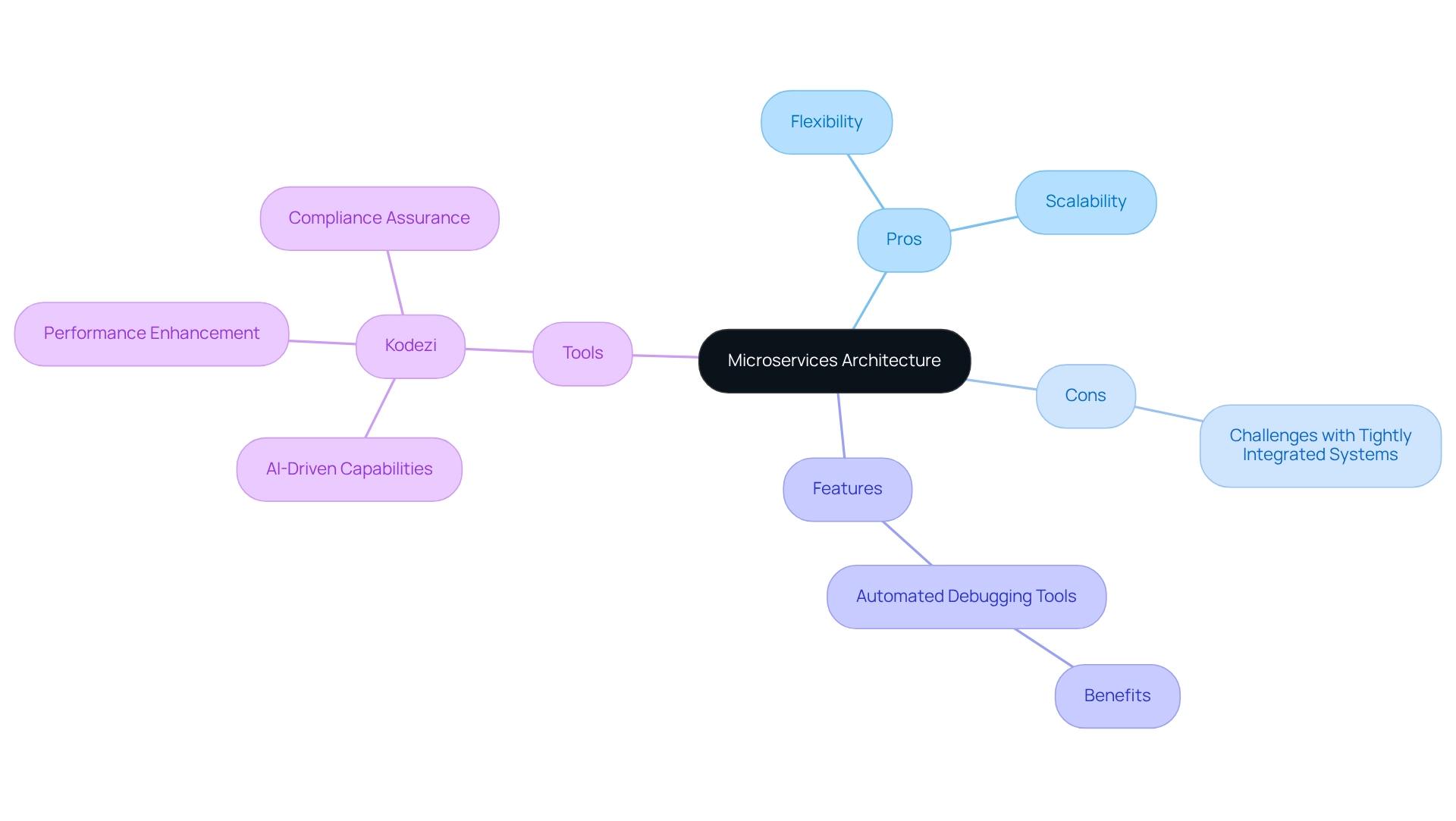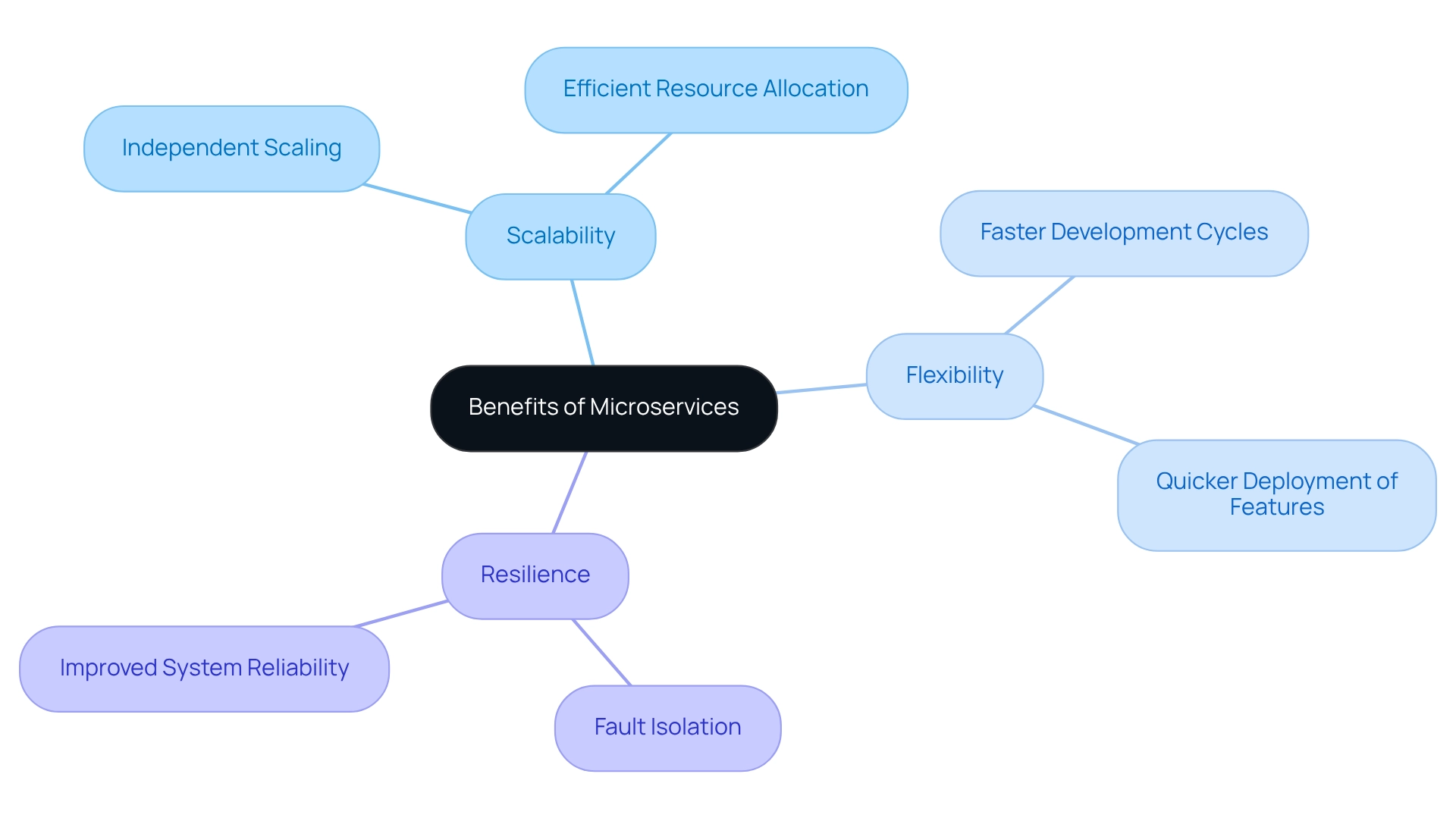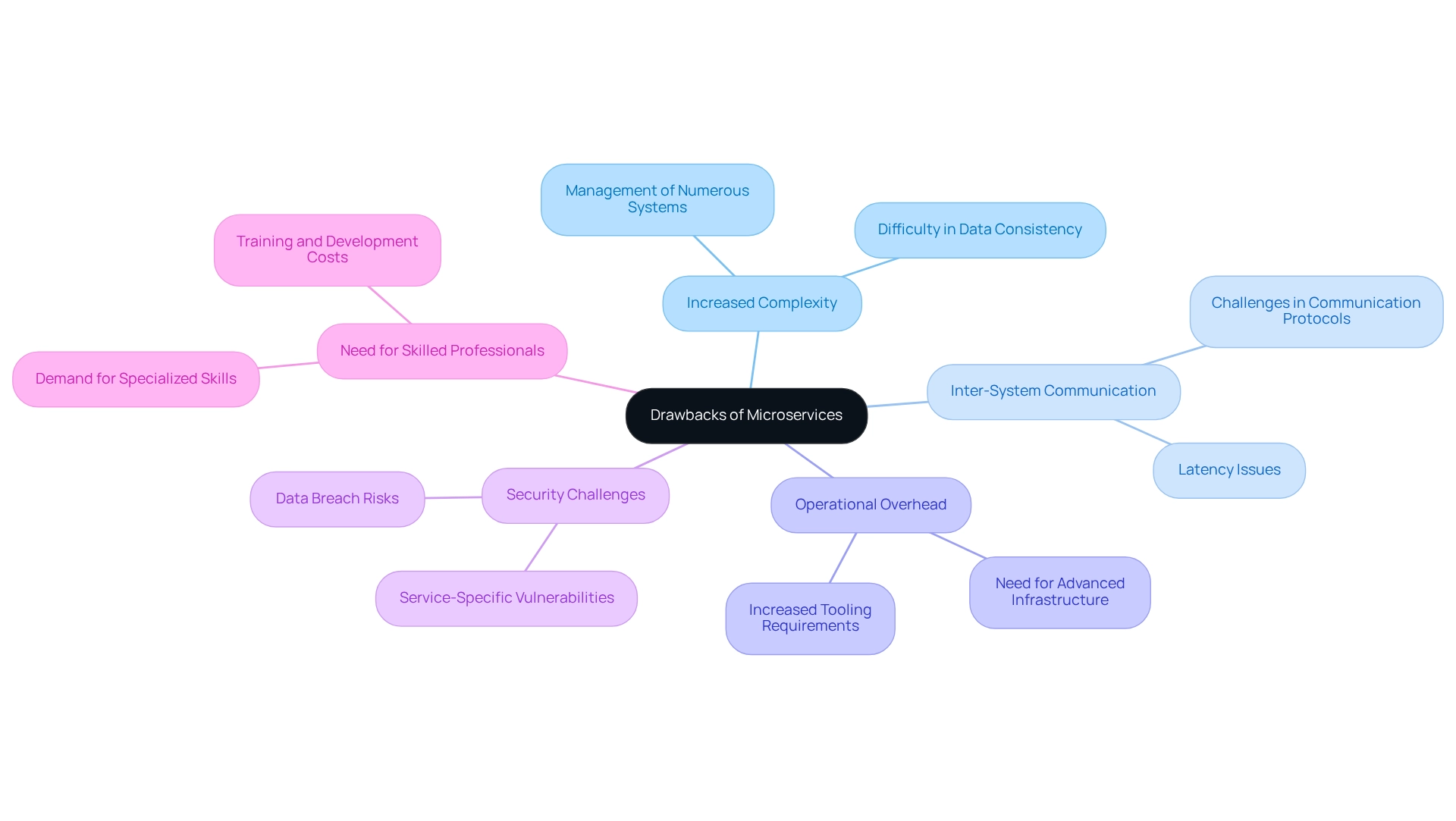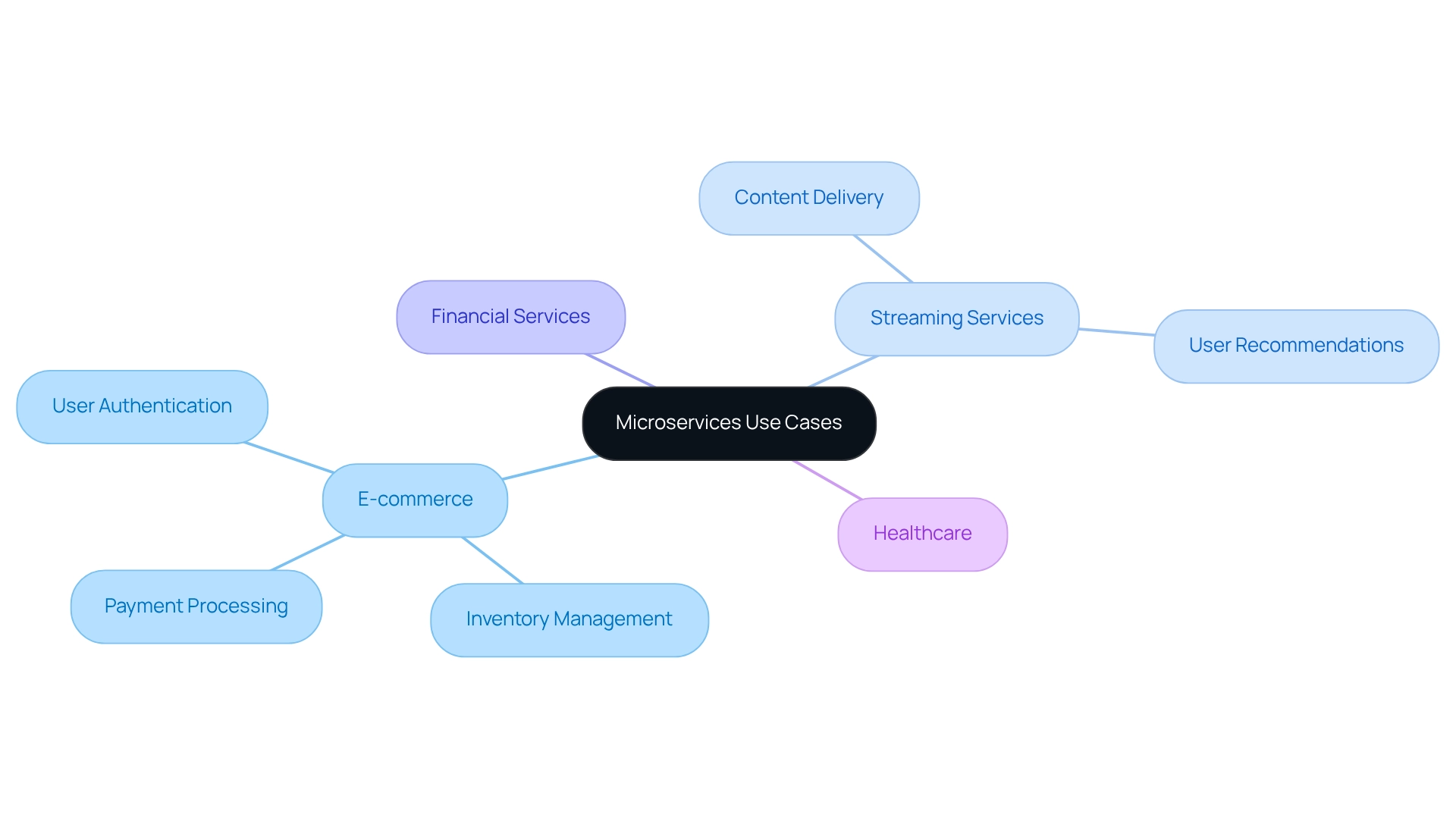Overview
The article begins by addressing the coding challenges that developers encounter with microservices architecture. It highlights the architecture's ability to enhance scalability, flexibility, and resilience in application development. Furthermore, it illustrates how microservices facilitate independent scaling and fault isolation, as seen in companies like Netflix and Amazon. However, it also notes the complexities and challenges this architecture introduces, including:
- Increased management complexity
- Potential security issues that organizations may face
This dual perspective encourages readers to reflect on the implications of adopting microservices in their projects.
Introduction
In the rapidly evolving landscape of software development, developers often face significant challenges. The microservices architecture has emerged as a transformative approach to address these issues, reshaping how applications are built and maintained. By breaking down applications into a collection of loosely coupled services, this model enhances scalability and flexibility while streamlining the development process.
As organizations strive to deliver faster and more reliable services, the advantages of microservices become increasingly apparent. However, this architectural style is not without its challenges, including:
- Increased complexity
- The need for robust management tools
Understanding the intricacies of microservices is essential for companies looking to innovate and adapt in a competitive digital environment.
Define Microservices Architecture
The pros and cons of microservices design provide a structural approach that organizes a system as a set of loosely connected components. Have you ever faced challenges in coding due to tightly integrated systems? Each offering in this design is tailored to execute a particular business function and can be created, launched, and expanded independently. This method stands in contrast to a monolithic structure, illustrating the pros and cons of microservices, where all elements are closely combined into one application.
In addition, the service-oriented architecture encourages flexibility, permitting teams to utilize various technologies and frameworks for distinct services. This flexibility can lead to enhanced scalability and quicker deployment cycles. Furthermore, the incorporation of automated code debugging tools, like those provided by Kodezi, significantly improves this framework. How can Kodezi help your team? By allowing teams to quickly detect and resolve codebase problems, enhance performance, and guarantee compliance with the latest security best practices, Kodezi streamlines the development process.
With Kodezi's AI-driven capabilities, teams can significantly improve code quality and productivity. Imagine the efficiency gains your team could achieve by leveraging such tools. Explore the powerful features available on the Kodezi platform and see how they can transform your coding practices.

Explore the Benefits of Microservices
Developers often face significant challenges when it comes to scalability, flexibility, and resilience in application design. The pros and cons of microservices architecture provide a compelling solution to these issues. By allowing each component to be scaled independently based on demand, it promotes more efficient resource allocation. Furthermore, this design supports continuous integration and continuous delivery (CI/CD), leading to faster development cycles and quicker deployment of new features.
In addition, the use of small, independent components enhances fault isolation. If one component experiences a failure, it does not necessarily lead to the collapse of the entire application, thereby improving overall system reliability. This resilience is crucial for maintaining a seamless user experience. Companies like Netflix and Amazon exemplify the effective utilization of microservices to enhance their delivery and user experience.
Have you considered how microservices could transform your application development? Embracing this architecture could significantly improve your productivity and the quality of your code. Explore the pros and cons of microservices to see how they can streamline your development process.

Examine the Drawbacks of Microservices
Despite their advantages, the pros and cons of microservices architecture present several notable challenges. One significant issue is the increased complexity of managing numerous systems, highlighting the pros and cons of microservices. This complexity can lead to difficulties in inter-system communication and maintaining data consistency, highlighting the pros and cons of microservices.
Furthermore, the implementation and oversight of various systems exemplify the pros and cons of microservices, as they require advanced infrastructure and tools, which can elevate operational overhead. Organizations may also encounter security challenges when considering the pros and cons of microservices, as each service can possess its own vulnerabilities. Additionally, understanding the pros and cons of microservices can pose a hurdle for certain firms due to the demand for skilled professionals.

Identify Use Cases for Microservices
The pros and cons of microservices architecture make it stand out as a solution for applications that demand high scalability and frequent updates. Consider e-commerce platforms like Amazon; they employ small, modular services to independently manage functions such as:
- Inventory management
- Payment processing
- User authentication
This approach allows them to tailor specific offerings based on traffic demands. Similarly, streaming services like Netflix leverage microservices to address various system components, including:
- Content delivery
- User recommendations
This enables updates without disrupting the entire framework. Other relevant applications can be found in:
- Financial services
- Healthcare
- Environments where understanding the pros and cons of microservices is essential for rapid development and deployment.

Conclusion
The exploration of microservices architecture unveils a dynamic approach to software development that presents both significant advantages and notable challenges. By structuring applications as a collection of loosely coupled services, organizations can achieve enhanced scalability, flexibility, and resilience. This architectural style supports rapid development cycles and allows for independent scaling of services, which is crucial for businesses that need to adapt quickly to changing demands.
However, the transition to microservices is not without its complexities. Managing numerous services can lead to challenges in communication, data consistency, and security. Furthermore, organizations must invest in robust infrastructure and skilled personnel to effectively implement and maintain a microservices architecture. Despite these hurdles, the successful application of microservices by industry leaders such as Netflix and Amazon illustrates the potential for improved service delivery and user experience.
In conclusion, understanding microservices architecture is essential for companies aiming to innovate in today’s competitive digital landscape. By weighing the benefits against the challenges, organizations can make informed decisions about adopting this architectural style to drive their development processes forward. Embracing microservices may well be a key step towards achieving greater agility and responsiveness in the face of evolving market demands.
Frequently Asked Questions
What are microservices in software design?
Microservices are a structural approach that organizes a system as a set of loosely connected components, each tailored to execute a specific business function.
How do microservices differ from monolithic architecture?
Unlike monolithic architecture, where all elements are closely integrated into one application, microservices allow for individual components to be created, launched, and expanded independently.
What are the advantages of using microservices?
The advantages of microservices include enhanced flexibility, the ability to use various technologies and frameworks for distinct services, improved scalability, and quicker deployment cycles.
How does Kodezi enhance the microservices framework?
Kodezi incorporates automated code debugging tools that help teams quickly detect and resolve codebase problems, enhance performance, and ensure compliance with the latest security best practices.
What impact can Kodezi's AI-driven capabilities have on development teams?
Kodezi's AI-driven capabilities can significantly improve code quality and productivity, leading to greater efficiency gains for development teams.
Where can I learn more about Kodezi's features?
You can explore the powerful features available on the Kodezi platform by visiting their website to see how they can transform your coding practices.



